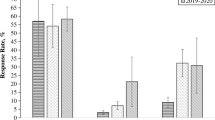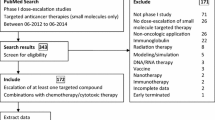Abstract
Pediatric cancer consists of a diverse group of rare diseases. The relatively small population of children with multiple, disparate tumor types across various age groups presents a significant challenge for drug development programs as compared to oncology drug development programs for adults. A recent review paper searched the written requests that were issued by the US FDA between 2001 and 2019. Many of the completed pediatric trials over the past 19 years have led to conclusions that the cancer drugs developed for adult cancer indications have not demonstrated sufficient effectiveness within the context of limited phase 1 and/or phase 2 studies in heavily pretreated patients (Akalu et al. in Pediatr Blood Cancer. https://doi.org/10.1002/pbc.28828, 2020). Faster learning and the implementation of futility criteria in the trial design should be considered in pediatric trials when the potential beneficial effects of investigational drugs may be unclear. In this paper, the authors compare the commonly used Simon’s 2-stage design in pediatric cancer trials to Bayesian sequential monitoring. The results show that the chance to stop for futility is at least doubled when a Bayesian design is used when compared to Simon’s 2-stage. The lower the true response rates are, the greater the number of patients would be saved from exposure to an ineffective treatment. To overcome the limitation of a small population and limited extrapolation opportunities, the innovative approach using Bayesian strategy to allow leveraging adult or external data in pediatric cancer trials should be considered.






Similar content being viewed by others
Availability of Data and Material
Not applicable.
Code Availability
Code available upon request.
References
Bavdekar SB (2013) Pediatric clinical trials. Perspect Clin Res 4(1):89–99
Wasylewski MT, Strzebonska K, Koperny M, Polak M, Kimmelman J, Waligora M (2020) Clinical development success rates and social value of pediatric Phase 1 trials in oncology. PLoS ONE. https://doi.org/10.1371/journal.pone.0234911
Akalu A, Meng X, Reaman G, Ma L, Yuan W, Ye J (2020) A review of the experience with pediatric written requests issued for oncology drug products. Pediatr Blood Cancer. https://doi.org/10.1002/pbc.28828
FDA. (n.d.). Eloxatin. United States prescribing information (USPI). https://www.accessdata.fda.gov/drugsatfda_docs/label/2020/021759s023lbl.pdf
FDA. (n.d.). Avastin. Retrieved from United States Prescribing Information (USPI). https://www.accessdata.fda.gov/drugsatfda_docs/label/2020/125085s336lbl.pdf
FDA. (n.d.). Taxotere United States precribing information (USPI). https://www.accessdata.fda.gov/drugsatfda_docs/label/2020/020449s084lbl.pdf
FDA. (n.d.). Taxol. United States precribing information (USPI). https://www.accessdata.fda.gov/drugsatfda_docs/label/2015/020262s051lbl.pdf
Congress.gov.S.3239 (2017) RACE for children act. https://www.congress.gov/bill/114th-congress/senate-bill/3239
Lim J, Walley R, Yuan J, Liu J, Dabral A, Best N, Bowen E, et al (2018) Minimizing patient burden through the use of historical subject-level data in innovative confirmatory clinical trials: review of methods and opportunities. Therap Innov Regul Sci 52(5):546–559
Ye J, Reaman G, De Claro R, Sridhara R (2020) A Bayesian approach in design and analysis of pediatric cancer clinical trials. Pharm Stat 19:814
Ivanova A, Paul B, Marchenko O, Song G, Patel N, Moschos SJ (2016) Nine-year change in statistical design, profile, and success rates of Phase II oncology trails. J Biopharm Stat 26(1):141–149
Simon R (1989) Optimal two-stage designs for phase II clinical trials. Control Clin Trials 10(1):1–10
Jung S-H, Carey M, Kim K (2001) Graphical search for two-stage designs for phase II clinical trials. Control Clin Trials 22:367–372
Koyama T, Chen H (2007) Proper inference from Simon’s two-stage designs. Stat Med. https://doi.org/10.1002/sim.3123
Pocock S (1976) The combination of randomized and historical controls in clinical trials. J Chronic Dis 29(3):175–188
Neuenschwander B, Capkun-Niggli G, Branson M, Spiegelhalter D (2010) Summarizing historical information on controls in clinical trials. Clin Trials 7:5–18
Schmidli H (2014) Robust meta-analytic-predictive priors in clinical trials with historical control information. Biometrics 70:1023–1032
Ibrahim J, Chen M, Gwon Y, Chen F (2015) The power prior: theory and applications. Stat Med 34(28):3724–3749
Hobbs B, Carlin B, Mandrekar S, Sargent D (2011) Hierarchical commensurate and power prior models for adaptive incorporation of historical information in clinical trials. Biometrics 67(3):1047–1056
Viele K, Berry S, Neuenschwander B, Amzal B, Chen F, Enas N, Thompson L, et al (2014) Use of historical control data for assessing treatment effects in clinical trials. Pharm Stat 13(1):41–54
Greenhouse J, Waserman L (1995) Robust Bayesian methods for monitoring clinical trials. Stat Med 14(12):1379–1391
Kass R, Greenhouse J (1989) A Bayesian perspective. Comment on “Investigating therapies of potentially great benefit: ECMO” by J.H. Ware. Stat Sci 4:310–317
Spiegelhalter D, Freedman L, Parmer M (1994) Bayesian approaches to randomized trials. J R Stat Soc Series A 157:357–416
Wiesenfarth M, Calderazzo S (2020) Quantification of prior impact in terms of effective current sample size. Biometrics 76:326–336
Harrell F (2019) Why a Bayesian approach to drug development and evaluation? whybayes: https://hbiostat.org/doc/bayes/whybayes.pdf
Chi Y, Chen C-M (2008) Curtailed wo-stage designs in phase II clinical trials. Stat Med 27(29):6175–6189
Herndon JE II (1998) A design alternative for two-stage, phase II multicenter cancer clinical trials. Control Clin Trials 19(5):440–450
Kim J, Schell MJ (2019) Modified Simon’s minimax and optimal two-stage designs for single-arm phase II cancer clinical trials. Ontotarget 10(42):4255–4261
Ye F, Shyr Y (2007) Balanced two-stage designs for phase II clinical trials. Clin Trials 4(5):514–524
Neelon B, O"Malley J (2010) Bayesian analysis using power priors with application to pediatric quality of care. J Biometr Biostat 1(1):1–9
Acknowledgements
The authors thank two referees for their insightful comments to improve the manuscript.
Funding
Not applicable.
Author information
Authors and Affiliations
Contributions
JY and GR designed the comparison. JY developed the method and did the simulations. JY and GR drafted and approved the manuscript.
Corresponding author
Ethics declarations
Conflict of interest
No conflicts of interest from the authors. JY is an employee of BeiGene.
Rights and permissions
About this article
Cite this article
Ye, J., Reaman, G. Improving Early Futility Determination by Learning from External Data in Pediatric Cancer Clinical Trials. Stat Biosci 14, 337–351 (2022). https://doi.org/10.1007/s12561-021-09332-4
Received:
Revised:
Accepted:
Published:
Issue Date:
DOI: https://doi.org/10.1007/s12561-021-09332-4




